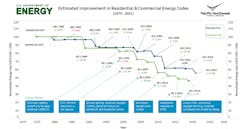2023 Energy Codes and Lighting & Control Requirements
National building codes govern residential and commercial construction requirements to protect against substandard living and working conditions. Energy codes are a subset of building codes, designed to promote energy efficiency in construction. There are four major energy codes in North America: ASHRAE 90.1, IECC, Title 24 Part 6, and NECB.
Most U.S. states and jurisdictions use the International Energy Conservation Code (IECC) model energy code as the basis for their local or state energy code — the majority of the rest follow the ASHRAE 90.1 Standard. Of the jurisdictions that use these codes, most simply adopt the IECC or 90.1 without modifications. ASHRAE 90.1 covers commercial buildings and residential structures four stories and higher. IECC and Title 24 Part 6 cover commercial buildings and all residential buildings. Title 24 Part 6 is exclusive to California, while most provinces in Canada use the National Energy Code for Buildings (NECB) as the basis for their local energy code.
Code updates
Codes are updated frequently (typically every three years) as new technologies, products, and strategies lead to greater opportunities for energy efficiency. According to the Department of Energy (DOE), a building designed to the minimum requirement of ASHRAE 90.1-2022 will be about 5% more energy efficient than one designed to 90.1-2016 (see the Figure below).
The Table (below) highlights the most current, published versions of each energy code. There is a lag between when a new version is published and when it is adopted by the states or local jurisdictions. For instance, many states are still moving to IECC 2021; some are still using IECC 2015 and moving to IECC 2018. Local jurisdictions (e.g., New York, N.Y. and Seattle, Wash.) can modify the state energy code to be more progressive and energy efficient than the state requires.
Title 24 is typically seen as the most progressive energy code in terms of promoting energy efficiency and often acts as a bellwether of where other codes might go. Title 24 has changes in 2023; some of the biggest in the commercial lighting arena include:
- Demand-responsive lighting — Buildings using more than 4,000W of total lighting power in spaces that have more than 0.5W/ft2 must have a demand-responsive lighting control system that can reduce lighting load by at least 15% when their utility sends a demand response signal.
- Open office lighting — In zones of 600 ft2 or less, lighting must be partially off (or fully off) when the zone is vacant.
Future code requirements
What’s on the horizon? Here are some of the likely future provisions to anticipate as well. Consult your local code for current requirements.
For lighting:
- More codes are likely to follow Title 24’s lead, adding requirements for demand-responsive lighting.
- More automatic, daylight responsive control in spaces with windows and/or skylights as the wattage threshold before the automatic daylight control is required will be lowered (e.g., 90.1-2022 lowered the wattage threshold to 75W [from 150W] of lighting power in all daylight zones in a space before daylight responsive control is required).
- Continuous daylight dimming will likely be mandated for spaces that must use daylight-responsive control. Previously, projects could comply with stepped daylight switching, which was disruptive to occupants and saved less energy than continuous daylight dimming.
- Dimmers will likely be required for certain spaces.
When you look at energy code trends, expect a continued focus on lighting control. Since LEDs are already so efficient, it is getting harder to reduce lighting power allowances without negatively affecting the occupant’s visual acuity. As a result, enhanced lighting control requirements may be needed instead of lower lighting power. Outside of lighting updates, future code changes will likely incorporate renewable energy and electric vehicle charging/parking requirements as well as requirements for buildings to accommodate energy storage (space for batteries).
We also expect changes to required additional energy efficiency measures that go beyond mandatory requirements. These will likely manifest as a point-based requirement for all projects. For instance, projects will have to achieve a certain number of additional energy efficiency measures to get the required number of points for their climate zone. This is in 90.1-2022 and likely will be in IECC 2024. Rather than dictate a specific strategy, projects will have a list of above-code energy efficiency measures to choose from and they must achieve some of them to meet the requirement.
- For lighting, there will likely be credits (points) for high-end trim of lighting, more occupancy sensor control, and lower lighting power allowances.
- Outside of lighting, there will likely be energy credits for automated window shading, increased HVAC efficiency, and building envelope performance.
Your role
How can electrical engineers and contractors navigate all these code changes? Start by working with manufacturers that help you design to meet code, provide products to support your projects, and make it easier to keep up with all the code changes in your area. These resources can help you find your code and create lighting specs for a wide range of applications.
Click here for additional code resources.
Michael Jouaneh is the manager of sustainability and energy standards for Lutron. He chairs the commercial Power, Lighting, and Renewables subcommittee for the 2024 International Energy Conservation Code (IECC). He is a vice chair of the ASHRAE 189.1 Standard for High-Performance Green Buildings committee. He is active with many standards-development organizations, including the California Energy Commission, National Electrical Manufacturers Association, and Illuminating Engineering Society.
About the Author

Michael Jouaneh
Manager — Sustainability and Energy Standards
Michael Jouaneh is the manager of sustainability and energy standards for Lutron. He chairs the commercial Power, Lighting, and Renewables subcommittee for the 2024 International Energy Conservation Code (IECC). He is a vice chair of the ASHRAE 189.1 Standard for High-Performance Green Buildings committee. He is on the board of Green Building United and is active with many standards-development organizations, including the California Energy Commission, National Electrical Manufacturers Association, and Illuminating Engineering Society.



